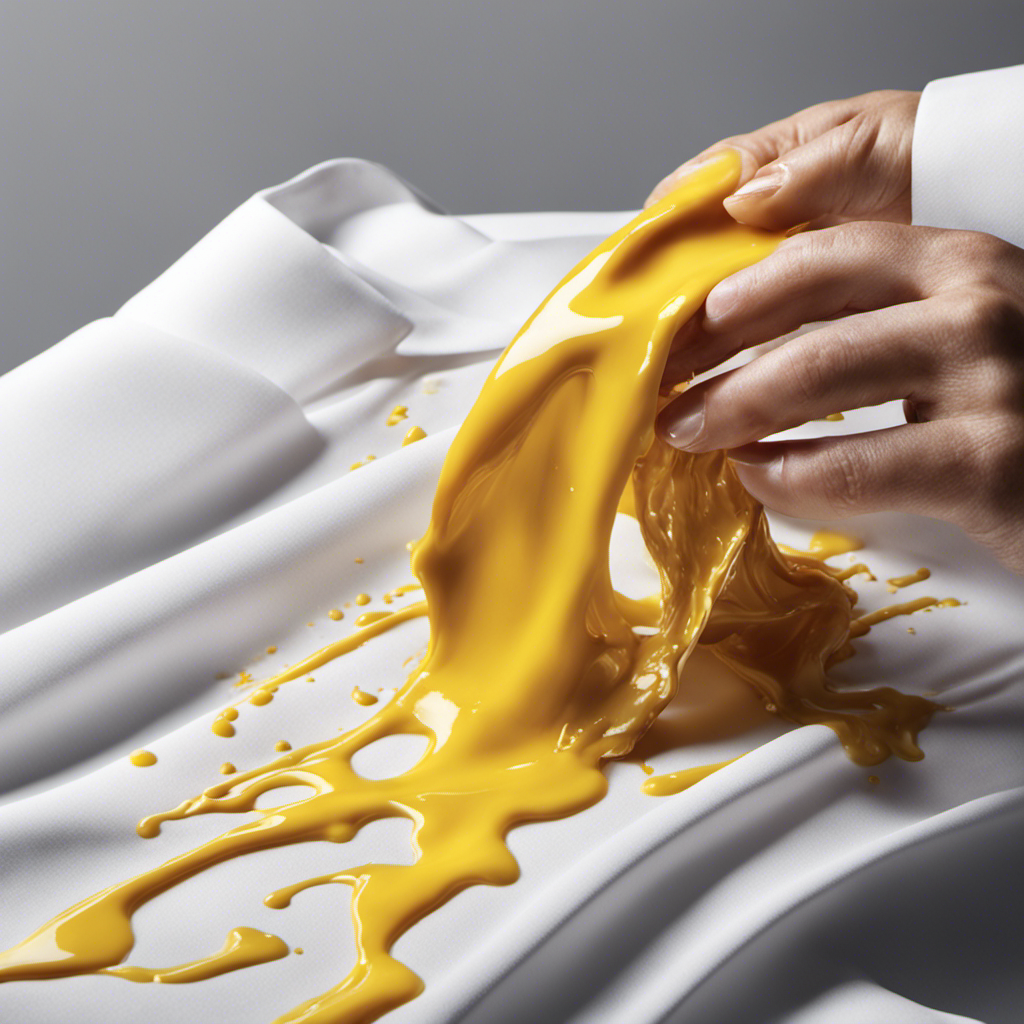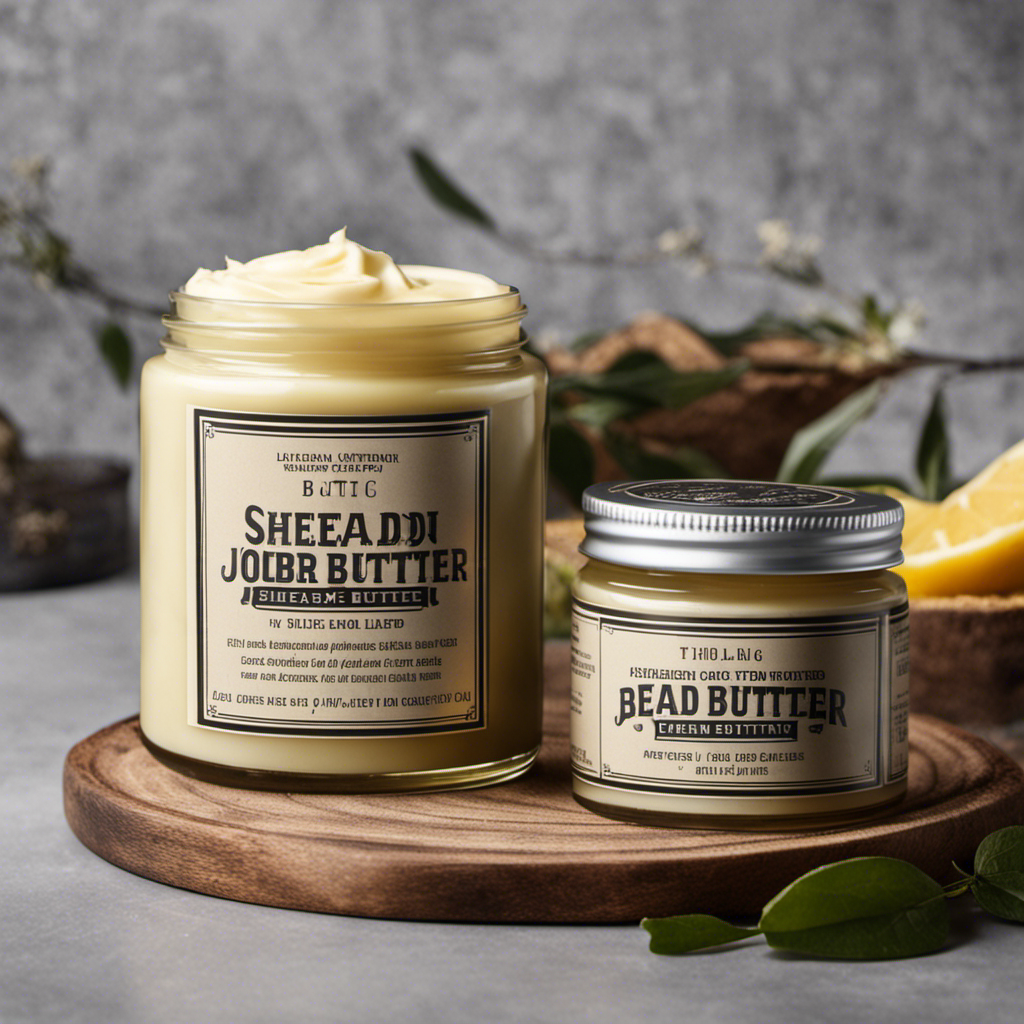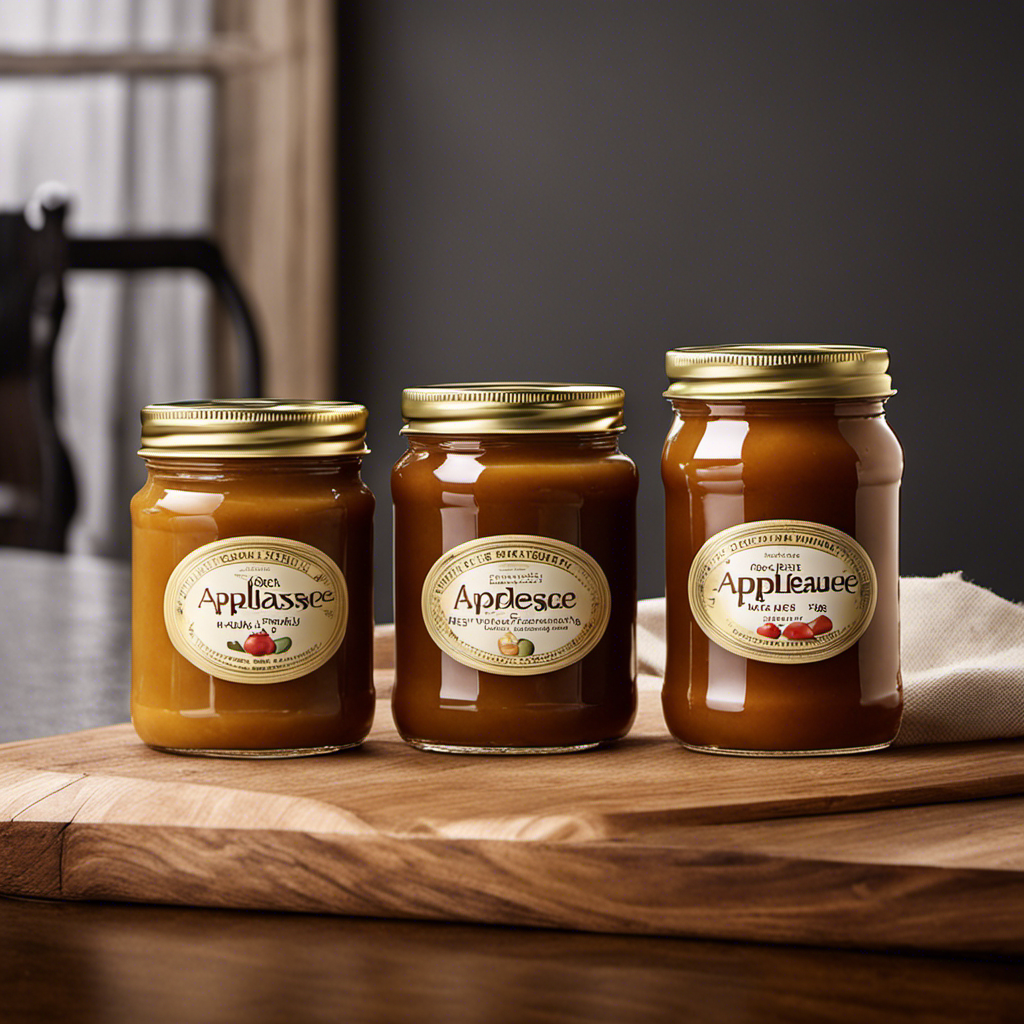Did you know that every year, thousands of people accidentally end up getting melted butter on their clothes?
It can be a frustrating and stubborn stain to remove, but fear not, for I have the solution for you.
In this article, I will guide you through a step-by-step process to effectively get melted butter out of your garments.
With a few simple techniques and some common household items, you’ll be able to tackle this pesky stain and save your favorite clothes from being ruined.
Let’s get started!
Key Takeaways
- Assess the fabric type and severity of the stain before attempting any removal method
- Gently scrape off excess butter using a blunt knife or spoon
- Apply dishwashing liquid or liquid detergent directly onto the stain and let it sit before rinsing
- Consider using baking soda or white vinegar as alternative stain removal methods if the stain persists
Assess the Stain
Now, take a moment to assess the stain on your clothes. Butter stains can be quite stubborn, but with the right techniques, they can be removed effectively.
When assessing the stain, it is important to consider the fabric of the garment and the severity of the stain. For delicate fabrics, such as silk or wool, it is best to take the garment to a professional cleaner. However, for most fabrics, you can start by gently scraping off any excess butter using a blunt knife or spoon.
Then, apply a small amount of dishwashing liquid directly onto the stain and gently rub it in. Let it sit for a few minutes before rinsing with warm water. Repeat this process until the stain is completely gone.
To prevent butter stains on clothes, it is advisable to be cautious while eating and avoid spilling butter as much as possible.
Scrape Off Excess Butter
First, you’ll want to gently scrape off any excess butter from the fabric. Use a butter knife or spoon to carefully lift away as much of the melted butter as possible. Be cautious not to spread the stain further or rub it into the fabric.
Here are some tips to help you remove butter stains and prevent them in the future:
- Blot the stain with a clean cloth or paper towel to absorb any remaining grease.
- Pretreat the stain by applying a small amount of liquid detergent or dish soap directly to the affected area.
- Gently rub the detergent into the stain using your fingertips or a soft brush.
- Let the detergent sit on the stain for about 10 minutes to penetrate the fabric.
- Rinse the stained area with cold water and repeat the process if necessary.
Blot the Stain
When it comes to removing greasy stains from fabric, it’s important to act quickly and effectively. Heat can actually damage the fabric further, so it’s crucial to avoid using hot water or applying heat to the stain.
If traditional stain removal methods aren’t working, there are alternative options to consider. One option is using dish soap to tackle the grease. Dish soap is designed to cut through grease and can be effective in removing greasy stains from fabric. Simply apply a small amount of dish soap to the stain, gently rub it in, and then rinse with cool water.
Another option is using baking soda. Baking soda is known for its ability to absorb odors and can also help absorb grease from fabric. To use baking soda, sprinkle a generous amount onto the greasy stain and let it sit for a few hours. Then, brush off the baking soda and launder the fabric as usual.
Removing Greasy Stains
To remove greasy stains from clothes, you can try using dish soap and warm water. This method is effective in breaking down the grease and lifting it from the fabric.
Simply mix a small amount of dish soap with warm water and apply it directly to the stain. Gently rub the fabric together to work the soap into the stain, then let it sit for a few minutes. Afterward, rinse the garment thoroughly with warm water.
If the stain persists, you can also try using baking soda or white vinegar as alternative methods. These household items can help to break down the grease and remove the stain.
To prevent future stains, consider applying a stain repellent spray to your clothes, especially on areas prone to greasy spills. Additionally, try to avoid placing greasy items directly on your clothing and promptly address any spills or stains that occur.
Heat Damages Fabric
Heat can cause damage to fabric if it is exposed for long periods of time. It is important to take preventive measures to protect our clothing from heat damage. Here are some fabric care tips to keep your clothes safe:
| Heat Damage Prevention | Fabric Care Tips |
|---|---|
| Avoid high heat settings when ironing | Use a lower heat setting or steam |
| Do not leave clothes in direct sunlight | Hang clothes in a shaded area |
| Avoid drying clothes on high heat | Opt for air drying or low heat settings |
| Keep clothes away from hot surfaces | Store them in a cool, dry place |
| Use heat-resistant fabrics for high-heat activities | Look for materials like cotton or linen |
Alternative Stain Removal
Using a mixture of vinegar and baking soda can be an effective alternative for removing stains from your clothes. I have personally found this method to be quite successful in tackling various types of stains, including grease, food, and even ink. Here are five reasons why you should consider using this natural stain remover:
-
It is environmentally friendly: Unlike harsh chemical cleaners, vinegar and baking soda are safe for the environment and do not release harmful toxins into the air or water.
-
It is cost-effective: Both vinegar and baking soda are inexpensive household items that can be easily found in your pantry, making this alternative cleaning method budget-friendly.
-
It is gentle on fabrics: Unlike some commercial stain removers, vinegar and baking soda are unlikely to damage or fade your clothes, making them a suitable option for delicate fabrics.
-
It is versatile: This stain removal method can be used on a wide range of fabrics, from cotton to silk, and is effective on both fresh and set-in stains.
-
It is easy to use: Simply mix equal parts vinegar and baking soda to form a paste, apply it to the stain, and let it sit for a few minutes before washing as usual.
Pretreat With Dish Soap
First, you’ll want to grab some dish soap and apply it directly to the melted butter stain on your clothes. Dish soap is known for its effectiveness in removing greasy stains, and it can work wonders on butter stains as well. The key is to choose a dish soap brand that is specifically designed to cut through grease and oil.
While there are many alternative dish soap brands available, some popular options include Dawn, Palmolive, and Seventh Generation. These brands are known for their powerful cleaning agents and ability to remove tough stains.
When applying the dish soap, make sure to gently rub it into the stain using a soft cloth or sponge. Allow it to sit for a few minutes before rinsing with cold water. Repeat the process if necessary until the butter stain is completely gone.
Use a Stain Remover Spray
To effectively remove a stain, you can try using a stain remover spray. It is a convenient and effective way to tackle tough stains on clothes. Here are some reasons why using a stain remover spray can be beneficial:
-
Quick and easy: Stain remover sprays are designed to be fast-acting and easy to use. Simply spray the stain, wait for a few minutes, and then wash the garment as usual.
-
Versatile: Stain remover sprays can be used on a variety of fabrics and stains, making them a versatile solution for different types of stains.
-
Targeted action: The spray nozzle allows for precise application, ensuring that the stain remover reaches the affected area directly.
-
Heat vs chemicals: Stain remover sprays often use a combination of heat and chemicals to break down and remove stains effectively.
-
DIY stain removers: Stain remover sprays can be easily made at home using ingredients like vinegar, hydrogen peroxide, or dish soap, providing a natural and cost-effective alternative.
Soak in Cold Water
When it comes to removing tough stains from clothing, there are a few key points to keep in mind.
First, pre-treating the stain with detergent can help break down the oils and proteins that cause the stain to set.
Next, using a stain remover specifically designed for the type of stain you’re dealing with can provide targeted cleaning power.
Finally, washing the garment with hot water can help to further dissolve and remove the stain, leaving your clothes looking fresh and clean.
Pre-Treat With Detergent
Before you start, make sure you have a detergent on hand to pre-treat the melted butter stain on your clothes. Pre-treating the stain is crucial in ensuring that it doesn’t set into the fabric and become more difficult to remove. Here are some alternatives to consider and common mistakes to avoid when pre-treating a melted butter stain:
- Use a liquid laundry detergent: This type of detergent is effective in breaking down the oils in the butter stain.
- Apply the detergent directly to the stain: Gently rub the detergent into the fabric to ensure maximum coverage.
- Let it sit: Allow the detergent to penetrate the stain for at least 10-15 minutes before washing.
- Avoid hot water: Hot water can cause the butter stain to set, so always use cold water when pre-treating.
- Test for colorfastness: Before applying the detergent, test a small, hidden area of the fabric to make sure it doesn’t cause any color fading or damage.
Use Stain Remover
Using a stain remover is an effective way to treat the butter stain on your clothes. When butter melts and gets onto your clothes, it can leave a greasy and stubborn stain. The heat from melted butter can cause the stain to set in, making it even more difficult to remove.
That’s where a stain remover comes in handy. Stain removers contain powerful enzymes and surfactants that break down and lift the grease from the fabric fibers. To use a stain remover, simply apply it directly to the butter stain and gently rub it in. Let it sit for a few minutes to allow the product to penetrate the stain. Then, wash the garment as usual.
If you prefer alternative methods, you can try using dish soap or a mixture of baking soda and water to treat the stain. However, be mindful that these methods might not be as effective in removing the grease completely and may require additional steps.
Wash With Hot Water
Washing your clothes with hot water can help to remove stubborn grease stains. The heat from the water helps to break down the grease, making it easier to remove from the fabric. When dealing with melted butter stains, using hot water can be particularly effective.
Here are five reasons why hot water is better than cold water for removing grease stains:
- Hot water helps to dissolve the grease, allowing it to be washed away more easily.
- The heat from the water can help to loosen the grease from the fabric fibers.
- Hot water can penetrate the fabric more effectively, reaching deep into the fibers to remove the grease.
- The warmth of the water can also help to break down any residual oils or fats in the stain.
- Using hot water in combination with a grease-fighting detergent can provide even better results in removing stubborn grease stains.
Apply a Laundry Detergent Paste
To remove melted butter from your clothes, you’ll need to apply a paste made from laundry detergent. This method is effective because the detergent helps to break down the grease and oil in the butter, allowing it to be easily removed from the fabric. When dealing with melted butter stains, it’s important to consider the temperature of the treatment. Heat can actually set the stain, making it more difficult to remove. Therefore, it is recommended to use cold water when treating butter stains. Additionally, dish soap can also be effective in removing butter stains. Its grease-fighting properties help to break down the butter and lift it from the fabric. However, it’s important to ensure that the dish soap is fully rinsed out to avoid any residue on the clothes.
| Heat Treatment | Cold Treatment |
|---|---|
| Can set the stain | Helps to prevent the stain from setting |
| Makes it more difficult to remove | Makes it easier to remove |
| Not recommended for butter stains | Recommended for butter stains |
Use a Stain Removal Stick
When treating stains, a stain removal stick can be a helpful tool to have on hand. It’s a portable and convenient way to tackle stubborn stains, including melted butter.
Here are five reasons why a stain removal stick is a must-have:
-
Easy application: Simply apply the stick directly to the stain and rub gently.
-
Targeted treatment: The stick’s formula is designed to penetrate the fabric and break down the stain.
-
Quick action: Stain removal sticks work fast, allowing you to treat the stain immediately.
-
Versatility: Stain removal sticks can be used on a variety of fabrics, including delicate ones.
-
Convenient for travel: The compact size of the stick makes it perfect for on-the-go stain emergencies.
Using a stain removal stick is a safe and effective method to remove melted butter stains from clothes without causing heat or fabric damage. It’s a reliable alternative to traditional stain removal methods.
Try a Vinegar Solution
When it comes to tackling stubborn stains like butter, two common household remedies often come to mind: vinegar and butter.
In this discussion, I will be comparing the effectiveness of vinegar in removing butter stains from clothes. Vinegar has long been praised for its versatile cleaning properties, and many people swear by it as a natural stain remover.
But does it really work in the battle against butter stains? Let’s dive into the details and find out.
Vinegar Vs. Butter Stains
If you’re dealing with butter stains on your clothes, vinegar can be a great alternative to remove them. Vinegar has many benefits when it comes to being a butter stain remover.
Here are some reasons why vinegar is an effective solution:
- Vinegar is a natural and non-toxic cleaning agent.
- It helps break down the grease and oils in butter stains.
- Vinegar is readily available and affordable.
- It can be used on a variety of fabrics without causing damage.
- Vinegar also helps to neutralize any odors left behind by the butter stain.
To use vinegar as a butter stain remover, simply mix equal parts vinegar and water, then apply the solution to the stained area. Gently blot the stain with a clean cloth until it lifts. Repeat if necessary and then wash the garment as usual.
Vinegar is a versatile and reliable option for tackling those stubborn butter stains on your clothes.
Effectiveness of Vinegar
Vinegar is an effective solution for removing butter stains due to its ability to break down grease and oils. When butter stains your favorite shirt, time is of the essence. Acting quickly is crucial to prevent the stain from setting.
Blotting up any excess butter with a paper towel is the first step. Then, pour a small amount of vinegar directly onto the stain and gently rub it in with a clean cloth. Let it sit for a few minutes to allow the vinegar to penetrate the fabric and break down the oils.
Afterward, wash the garment as usual, and the butter stain should be gone. If you don’t have vinegar on hand, lemon juice or dish soap can be used as alternatives. However, vinegar is the preferred choice due to its various benefits, such as being natural, cost-effective, and readily available in most households.
Wash in the Hottest Water Safe for the Fabric
To remove melted butter from your clothes, simply wash them in the hottest water that is safe for the fabric. Heat is essential in breaking down the grease and oil molecules present in the butter, allowing them to be easily washed away.
Cold water may not be as effective, as it does not have the same ability to dissolve and remove the butter stains. Additionally, using dish soap can greatly enhance the cleaning process. The dish soap contains surfactants that help break down the butter and lift it from the fabric fibers.
When washing the clothes, make sure to pretreat the stains by applying a small amount of dish soap directly to the affected area and gently rubbing it in. Then, add more dish soap to the washing machine to boost its cleaning power.
Air Dry and Check for Residual Stain
After washing, you should air dry your clothes and then check for any residual stains. Air drying has many benefits when it comes to preserving the quality and longevity of your garments. Not only does it save energy and money, but it also helps prevent shrinkage and color fading. By allowing your clothes to naturally dry, you avoid subjecting them to the harsh heat of a dryer, which can be damaging to delicate fabrics. Additionally, air drying reduces the risk of residual stains setting in. When you air dry, you have the opportunity to closely inspect your clothes for any remaining stains that may not have been completely removed during the washing process. This allows you to treat the stains promptly before they become more difficult to remove.
| Benefits of Air Drying | Residual Stain Prevention |
|---|---|
| Saves energy and money | Allows for closer inspection |
| Prevents shrinkage and color fading | Promotes prompt stain treatment |
| Gentle on delicate fabrics | Avoids setting in of residual stains |
Frequently Asked Questions
Can I Use Hot Water Instead of Cold Water to Soak the Stained Clothes?
Yes, you can use hot water to soak stained clothes, but it may set the butter stain. It’s best to use cold water first to remove excess butter, then treat the stain with alternative methods like dish soap or a stain remover.
What Types of Fabrics Are Safe to Use a Stain Remover Spray On?
When it comes to stain remover sprays, it’s important to consider the fabric type. Different fabrics have different sensitivities, so check the label and opt for sprays that are safe for your garment.
How Long Should I Let the Dish Soap Pretreatment Sit Before Washing the Clothes?
I usually let the dish soap pre treatment sit for about 30 minutes before washing the clothes. It’s important to give it enough time to penetrate the stain and loosen the butter. If you’re looking for alternative pre treatment methods, vinegar or baking soda can also be effective.
Will Using a Stain Removal Stick on Delicate Fabrics Cause Damage?
Using stain removal sticks on different types of stains, such as butter, can be effective. However, it’s important to be cautious when using them on delicate fabrics as they may cause damage. Alternatively, vinegar can be an effective alternative to stain remover sticks.
Can I Use a Hairdryer to Speed up the Drying Process After Removing the Stain?
Using a hairdryer can be effective in speeding up the drying process after removing a stain. However, there are alternative methods like air drying or using a fan that can also be used.
Conclusion
So there you have it – a step-by-step guide on how to get melted butter out of clothes. By following these methods, you can effectively remove the stain and restore your clothing to its former glory.
Now, you might be thinking, ‘But what if these methods don’t work?’ Well, it’s important to remember that not all stains are the same, and some may require more than one attempt to fully eliminate. Don’t get discouraged if the stain persists, just keep trying different techniques until you find the one that works for you.
With a little patience and persistence, you’ll be able to conquer any butter stain that comes your way.










